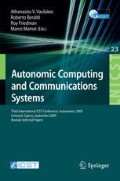Abstract
Deficient safety occurrence reporting by air traffic controllers is an important issue in many air traffic organizations. To understand the reasons for not reporting, practitioners formulated a number of hypotheses, which are difficult to verify manually. To perform automated, formally-based verification of the hypotheses an agent-based modeling and simulation approach is proposed in this paper. This approach allows modeling both institutional (prescriptive) aspects of the formal organization and social behavior of organizational actors. To our knowledge, agent-based organization modeling has not been attempted in air traffic previously. Using such an approach four hypotheses related to consequences of controller team composition in particular organizational contexts were examined.
Access this chapter
Tax calculation will be finalised at checkout
Purchases are for personal use only
Preview
Unable to display preview. Download preview PDF.
References
Ek, A., Akselsson, R., Arvidsson, M., Johansson, C.R.: Safety culture in Swedish air traffic control. Safety Science 45(7), 791–811 (2007)
Eurocontrol: Air navigation system safety assessment methodology. SAF.ET1.ST03.1000-MAN-01, edition 2.0 (2004)
Hersey, P., Blanchard, K.H., Johnson, D.E.: Management of Organizational Behavior: Leading Human Resources (2001)
Hofstede, G.: Cultures and Organizations. McGraw-Hill, New York (2005)
Kleijnen, J.P.C.: Verification and validation of simulation models. European Journal of Operational Research 82(1), 145–162 (1995)
Patankar, M.S., Brown, J.P., Treadwell, M.D.: Safety ethics. Ashgate (2005)
Pinder, C.C.: Work motivation in organizational behavior. Prentice-Hall, NJ (1998)
Pritchett, A.R., Lee, S., Goldsman, D.: Hybrid-System Simulation for National Airspace System Safety Analysis. AIAA Journal of Aircraft 38(5), 835–840 (2001)
Saltelli, A., Ratto, M., Andres, T., Campolongo, F., Cariboni, J., Gatelli, D., Saisana, M., Tarantola, S.: Global Sensitivity Analysis: The Primer. Wiley-Interscience, Hoboken (2008)
Sharpanskykh, A.: On Computer-Aided Methods for Modeling and Analysis of Organizations. PhD thesis, Vrije Universiteit Amsterdam (2008)
Sharpanskykh, A., Stroeve, S.H.: Safety modelling and analysis of organizational processes in air traffic – Deliverable D5: Validation plan. NLR, report NLR-CR-2008-653 (2008)
Stroeve, S.H., Blom, H.A.P., Van der Park, M.N.J.: Multi-agent situation awareness error evolution in accident risk modelling. In: 5th ATM R & D Seminar (2003)
Tumer, K., Agogino, A.: Distributed agent-based air traffic flow management. In: AAMAS 2007, pp. 342–349. ACM Press, New York (2007)
Young, P.C.: Data-based mechanistic modelling, generalised sensitivity and dominant mode analysis. Comput. Phys. Commun. 117, 113–129 (1999)
Appendix, http://www.few.vu.nl/~sharp/app.pdf
Author information
Authors and Affiliations
Editor information
Editors and Affiliations
Rights and permissions
Copyright information
© 2010 ICST Institute for Computer Science, Social Informatics and Telecommunications Engineering
About this paper
Cite this paper
Sharpanskykh, A. (2010). Consequences of Social and Institutional Setups for Occurrence Reporting in Air Traffic Organizations. In: Vasilakos, A.V., Beraldi, R., Friedman, R., Mamei, M. (eds) Autonomic Computing and Communications Systems. AUTONOMICS 2009. Lecture Notes of the Institute for Computer Sciences, Social Informatics and Telecommunications Engineering, vol 23. Springer, Berlin, Heidelberg. https://doi.org/10.1007/978-3-642-11482-3_12
Download citation
DOI: https://doi.org/10.1007/978-3-642-11482-3_12
Publisher Name: Springer, Berlin, Heidelberg
Print ISBN: 978-3-642-11481-6
Online ISBN: 978-3-642-11482-3
eBook Packages: Computer ScienceComputer Science (R0)

